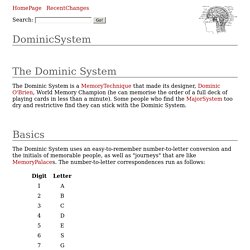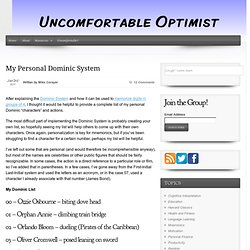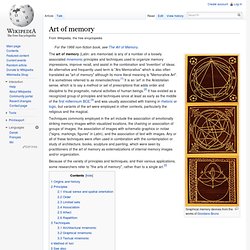

The Skillful Brain. Where it all begins, master your memory with these tutorials. Mnemonic dominic system. Dominic System. The Dominic System is a MemoryTechnique that made its designer, Dominic O'Brien, World Memory Champion (he can memorise the order of a full deck of playing cards in less than a minute).

Some people who find the MajorSystem too dry and restrictive find they can stick with the Dominic System. Basics. Home Page. This wiki is a collaborative environment for exploring ways to become a better thinker.

Topics that can be explored here include MemoryTechniques, MentalMath, CriticalThinking, BrainStorming, ShorthandSystems, NotebookSystems, and SmartDrugs. Other relevant topics are also welcome. SiteNews Wiki Topics Mindhacker: The support page for the 2011 book by RonHaleEvans and MartyHaleEvans. MindPerformanceHacks: The support page for the 2006 book of the same name by RonHaleEvans.
Easily memorize complex information - MemoryTechnique Do hard math in your head - MentalMath Improve your intelligence Think better. My Personal Dominic System. After explaining the Dominic System and how it can be used to memorize digits in groups of 4, I thought it would be helpful to provide a complete list of my personal Dominic “characters” and actions.

The most difficult part of implementing the Dominic System is probably creating your own list, so hopefully seeing my list will help others to come up with their own characters. Once again, personalization is key for mnemonics, but if you’ve been struggling to find a character for a certain number, perhaps my list will be helpful. I’ve left out some that are personal (and would therefore be incomprehensible anyway), but most of the names are celebrities or other public figures that should be fairly recognizable. MemoryMethods.com - memory techniques, memory tools, study tools, memorize, mnemonics. Mnemonics - Memory Techniques. Intelligence/Development/Brain Power. Memory. Memory Bloke - Contents Page - Site Map. Memory Improvement Techniques - Improve Your Memory with MindTools. © VeerPRZEMYSLAW PRZYBYLSKI Use these techniques to improve your memory.
The tools in this section help you to improve your memory. They help you both to remember facts accurately and to remember the structure of information. The tools are split into two sections. Firstly you'll learn the memory techniques themselves. As with other mind tools, the more practice you give yourself with these techniques, the more effectively you will use them.
Mnemonics 'Mnemonic' is another word for memory tool. The idea behind using mnemonics is to encode difficult-to-remember information in a way that is much easier to remember. Our brains evolved to code and interpret complex stimuli such as images, colors, structures, sounds, smells, tastes, touch, positions, emotions and language. Art of memory. The art of memory (Latin: ars memoriae) is any of a number of a loosely associated mnemonic principles and techniques used to organize memory impressions, improve recall, and assist in the combination and 'invention' of ideas.

An alternative and frequently used term is "Ars Memorativa" which is also often translated as "art of memory" although its more literal meaning is "Memorative Art". It is sometimes referred to as mnemotechnics.[1] It is an 'art' in the Aristotelian sense, which is to say a method or set of prescriptions that adds order and discipline to the pragmatic, natural activities of human beings.[2] It has existed as a recognized group of principles and techniques since at least as early as the middle of the first millennium BCE,[3] and was usually associated with training in rhetoric or logic, but variants of the art were employed in other contexts, particularly the religious and the magical. Origins and history[edit] Cognition. How to Remember a List of 10 Items in any order Method 2- Accelerated Learning. The Magical Number Seven, Plus or Minus Two. "The Magical Number Seven, Plus or Minus Two: Some Limits on Our Capacity for Processing Information"[1] is one of the most highly cited papers in psychology.[2][3][4] It was published in 1956 by the cognitive psychologist George A.

Miller of Princeton University's Department of Psychology in Psychological Review. It is often interpreted to argue that the number of objects an average human can hold in working memory is 7 ± 2. This is frequently referred to as Miller's Law. Mnemonic. Knuckle mnemonic for the number of days in each month of the Gregorian Calendar.

Each protruding knuckle represents a 31-day month. A mnemonic (RpE: /nəˈmɒnɨk/,[1] AmE: /nɛˈmɑːnɪk/ the first "m" is silent), or mnemonic device, is any learning technique that aids information retention. Mnemonics aim to translate information into a form that the brain can retain better than its original form. Even the process of merely learning this conversion might already aid in the transfer of information to long-term memory. Commonly encountered mnemonics are often used for lists and in auditory form, such as short poems, acronyms, or memorable phrases, but mnemonics can also be used for other types of information and in visual or kinesthetic forms.
Nook And Cranny Method. This is a method for expanding the capacity of a MemoryPalace tenfold without adding extra rooms.

It seems to have been developed by Scott_Hagwood? , the first Grandmaster of Memory from the US. He used it to play the longest game of Simon on record: 31 sequences of light and sound.